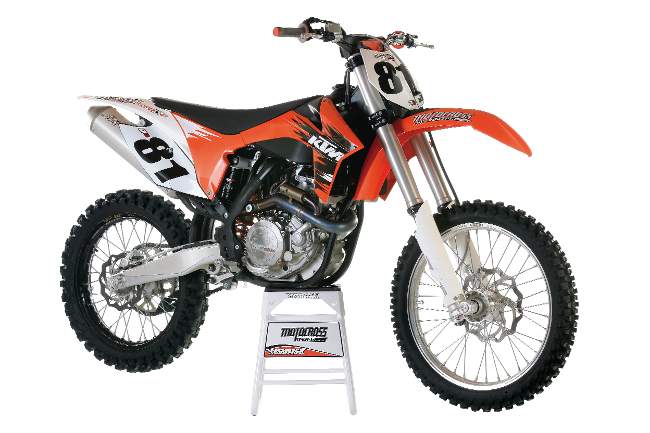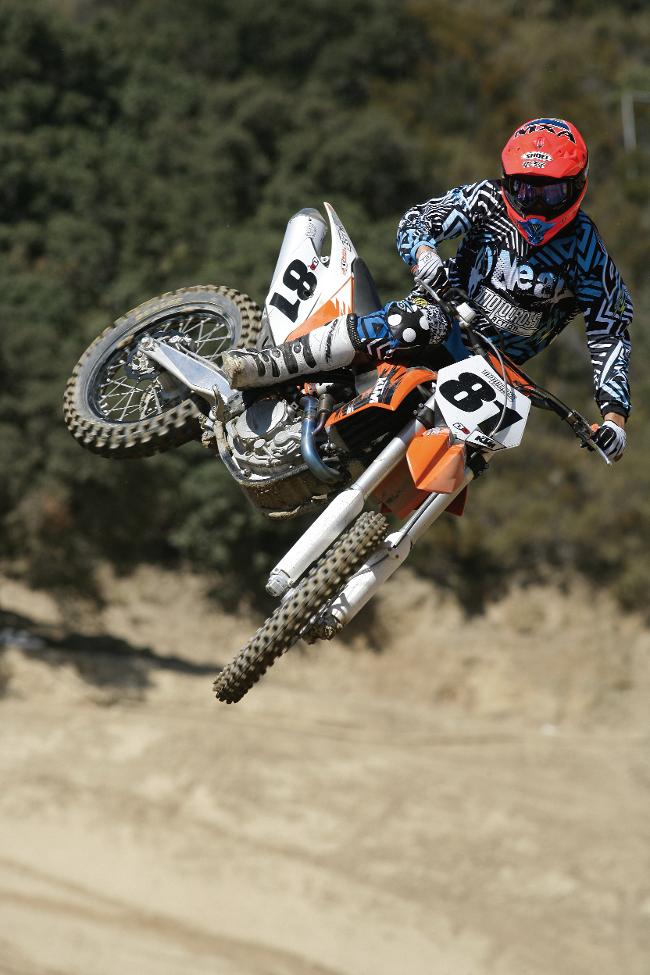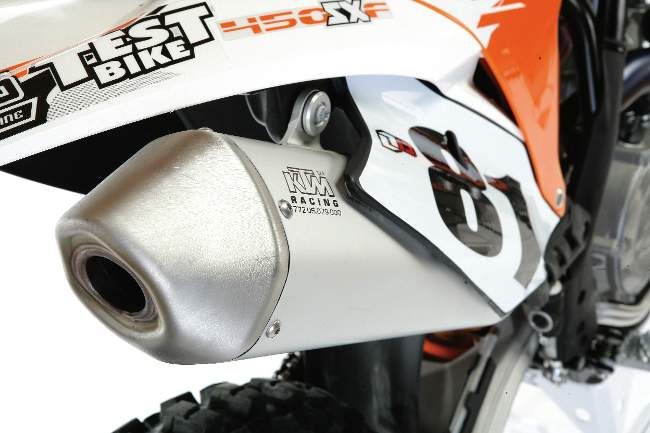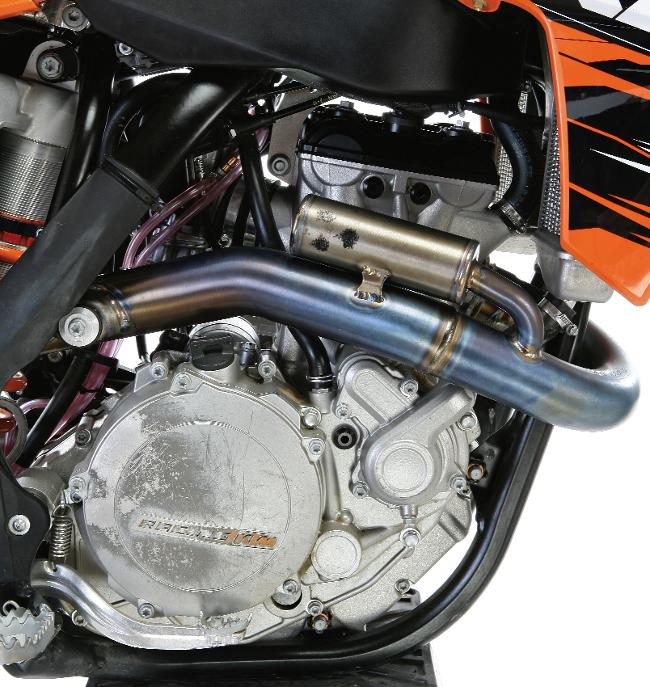2011 KTM 450SXF MOTOCROSS TEST: EVERYTHING YOU NEED TO KNOW ABOUT THE BIG-BORE KTM MOTOCROSS BIKE

Q: FIRST AND FOREMOST, IS THE 2011 KTM 450SXF BETTER THAN THE 2010 KTM 450SXF?
A: Yes. Why? Because it has the same great brakes, superb handling and incredible powerband as last year in a smaller, shrink-wrapped package?all the good stuff in fancier attire.
Q: HOW DOES THE KTM 450SXF ENGINE DIFFER FROM THE 350SXF?
A: With the addition of the 350SXF to their line, KTM offers two bikes that are legal in the 450 class. On the whole, the two bikes share a lot of parts (plastic, wheels, brakes, suspension components, linkage, swingarm and accoutrements), but there are significant differences.
(1) Carb. The 450SXF is not fuel-injected. It uses a 41mm Keihin FCR flat-slide carburetor with an integrated accelerator pump.
(2) Clutch. The 450SXF uses an aluminum clutch basket (which mimics the original six-spring CRF450 clutch). The 350SXF?has a steel clutch basket.
(3) Horsepower. The 350SXF makes 46.94 horsepower, and the 450SXF makes 53.92 horsepower. Rounded off, there is an 8 horsepower difference from the 250 to the 350 and from the 350 to the 450. Additionally, peak horsepower on the 450SXF is 8200 rpm. The 350SXF hits max power at a very high 12,200 rpm.
(4) Bore and stroke. The 350SXF has an 88mm x 57.5mm bore and stroke, while the 450SXF is 97mm x 60.8mm.
(5) Electric starter. The starter motor on the 450SXF is slightly larger than the 350SXF starter.
(6) Exhaust system. Although the 350/450SXF muffler is the same on both bikes, the rest of the pipe is dimensionally different.
Q: HOW DOES THE KTM 450SXF CHASSIS DIFFER FROM THE 350SXF CHASSIS?
A: The chassis of the 250, 350 and 450SXF all use the same steering head, plastic, wheels, rims, brakes, hubs, triple clamps, backbone, shock tower and swingarm. However, the 450SXF frame differs from its smaller brothers in that the engine cradle is larger and thicker.

2011 KTM 450SXF: Imagine the KTM?350SXF, only with eight more horsepower, and you have the 2011 KTM 450SXF. It shares virtually every component, part and piece with its little brother.
Q: DOES THE NEW MIDSIZE KTM 350SXF MAKE THE 450SXF OBSOLETE?
A: No?a big, giant gorilla-in-the-room, unabashed no. Given the choice between a 450SXF and a 350SXF, every one of MXA’s 450 test riders chose the 450 over the 350. Why? The most common answer was that the 450 had more power everywhere and that the power was easier to use, simpler to modulate and had more than enough ponies on demand (for when they were needed). None of them believed that the KTM 450SXF was too powerful?and instead they wished for more power for the start, big hills, deep loam and side-by-side drag races out of corners. They all wanted as much power as possible?and they didn’t want to have to rev a smaller engine to make up for an 8- to 10-horsepower disadvantage.
As you would expect, every 450-based MXA test rider felt that the 350SXF required them to rev the engine too high to even come close to the same speed as the KTM 450SXF (and that the two-stage 350SXF powerband wasn’t as effective on a race track as it was on a practice track). The caveat is that virtually every one of MXA‘s 250-based test riders preferred the 350 over the 450.
Q: HOW DOES THE 2011 KTM 450SXF DIFFER FROM THE 2010 450SXF?
A: In the important areas, the 2010 and 2011 450SXFs are remarkably alike. If you perused the KTM parts book, you would not find any new engine parts on the 2011 that weren’t on the 2010 (even the jetting is the same). Because of the new chromoly chassis, the exhaust pipe is slightly different (it has less clearance dents) and the muffler has a larger diameter outlet hole (from 33mm to 36mm).
The frame layout is new, but the geometry is basically the same as 2010. The ergonomics on the 2011 are much sleeker and lower. The American version of the 2011 KTM 450SXF has a 4mm shorter shock than the Euro specs, which lowers the rear of the bike 13mm at the axle. Obviously, the airbox, air filter and airboot are new. The airboot has a larger opening at the velocity stack and is more tapered toward the carb (the older airboot was a straight tube).
Q: HOW MUCH DOES THE 2011 KTM 450SXF WEIGH?
A: It weighs 242 pounds (without gas). Just for comparison, the 350SXF weighed 237 pounds on the MXA scale. The KTM 450SXf is on par with the werght of the YZ450F, KX450F and RM-Z450?but for that same weight you get electric start with a KTM. The Honda CRF450 is ten pounds lighter than the competition.
Q: IS THE 2011 450SXF FASTER THAN THE 2010 450SXF?
A: No. It is the exact same speed as the 2010 450SXF because it has the exact same engine, gearbox and drivetrain as the 2010 bike.
Q: HOW GOOD IS THE 2011 KTM 450SXF’S POWERBAND?
A: This is an awesome powerband. It produces the kind of power that offers the benefits of a manageable low-to-mid powerband with an impressive high-rpm top-end. The power is not scary to use, because it pulls across a long range. There is no herky-jerky throttle response like on some fuel-injected 450s. The KTM 450SXF builds power as the rpm increases, which means that if you want to go faster, all you have to do is leave the throttle pegged.

Plus list: The 450SXF has awesome brakes, manageable low end power, blazing fast top-end, superb handling, bulletproof hydraulic clutch and life-changing electric start.
We love this powerband; it is deceptively fast. The first impression is that it is slow, but it just keeps getting faster and faster as you roll the throttle on. The best thing about KTM’s powerband is that the mellow low-end makes the 450cc of power easier to use in tight corners and bumps, while the massive gain from the middle to the top gobbles up ground.
Q: WOULD THE KTM 450SXF RUN BETTER IF IT WERE FUEL INJECTED?
A: We don’t want to find out. The typical fuel-injected 450cc motocross bike has a crisp, over-caffeinated low-end hit and a flat top-end. That is the opposite of the way the 2011 KTM 450SXF runs. It has a sweet, well-modulated low-end and a raging top-end. KTM has a fuel-injected 450SXF works bike running on the GP circuit, but we prefer the trusty Keihin FCR.
Q: HOW IS THE JETTING?
A: We didn’t have to change any jets on the 2011 KTM 450SXF. This is a no hassle carb. MXA‘s recommended jetting is as follows:
Main: 185
Pilot: 42
Needle: OBDTQ
Clip position: 6th from top
Fuel screw: 1-3/4 turns
Leak jet: 50
Notes: The leak jet and fuel screw adjustments were the only jetting changes we had to make. We recommend an R&D Power Pump II to take full advantage of the ability to fine-tune the leak jet.
Q: IS IT A GOOD THING THAT THE NO-LINK SUSPENSION IS GONE?
A: Unlike the vast majority of naysayers in the motocross world, the MXA wrecking crew was never opposed to KTM’s no-link suspension system. That isn’t to say that we liked their setup, choice of rising rate, damping or spring rates, but we always felt that the system had the potential to work. And last year’s no-link rear suspension was the proof in the pudding. The 2010 KTM 450SXF’s rear suspension was comparable or better than the suspension of the CRF450, KX450F and RM-Z450 (but it wasn’t better than the Yamaha YZ450F’s suspension). So, in a way, we are sorry to see it go.
Q: HOW DOES THE 2011 KTM SHOCK LINKAGE WORK?
A: The 2011 KTM 250, 350 and 450SXFs come with rising-rate linkage, while the KTM 125SX, 150SX and 250SX two-strokes stick with the modified no-link PDS system. It is no secret that KTM did not want to go to a Japanese-style rising-rate linkage, but they had no choice?public opinion forced the move to linkage.
When the rear wheel moves upward, the rising rate of the shock linkage’s arc forces the shock shaft to move faster (even though the rear wheel is still moving at a constant rate). Guess what? KTM’s no-link PDS system does the same thing. So what is the difference? The new linkage can be fine-tuned more easily at the factory (by changing the eccentric cam profile) to make the shock have more damping at the very end of the stroke. On the other hand, the no-link system is lighter, easier to work on and produces a more linear spring progression. If there is a noticeable difference, it should only be felt in the last inch of the shock’s stroke.

Interchange: KTM’s are the quietest bikes on the track. The 450SXF is the only production 450 to pass both the AMA’s 94 dB static test and FIM 115dB wide open sound test.
Q: IS?THE KTM LINKAGE BETTER THAN THE PREVIOUS NO-LINK PDS SYSTEM?
A: Given that we liked last year’s no-link setup, it was an uphill battle to convince us that the linkage was worth the trouble (and the extra weight). Surprise! We liked the KTM linkage system. Perhaps that is because KTM used the Yamaha YZ450F system as a guideline. Its main advantage over the previous PDS system is that the linkage is more “contractive.” What does that mean? The PDS no-link system always felt like it was fully extended, whereas the new linkage system seems to take a set with travel left in both directions. The linkage allows the shock to both extend and contract from its base setting. Equally surprising was that the big gain that we expected in the pesky G-out area, where the shock tended to bottom in low-speed/high-G situations, never materialized.
All in all, we would say that KTM’s linkage rear end is a positive step, but that the ultimate expression will probably come with longer linkage arms and a stiffer spring. We have tested several different link arms with some success and are still dialing in the final length (and we have seen KTM’s test department running the same linkage tests as the MXA crew).
We were glad that the overall feel of the KTM’s rear suspension didn’t change drastically in the swap from no-link to linkage. KTM had the no-link working very well in 2010 and it would have been a shame to ruin it. As for why it didn’t change very much?when you use the same engineers and test riders that developed the no-link suspension to develop the linkage suspension they don’t stop testing until they get the feel they like. Which in this case, was the feel of the no-link.
Q: WHAT WAS OUR BEST SHOCK SETTING?
A: For hardcore racing, we recommend this shock setup for the 2011 KTM 450SXF:
Spring rate: 5.7 kg/mm stock
Race sag: 100mm
Hi-compression: 1-1/4 turn out
Lo-compression: 12 clicks out
Rebound: 12 clicks out
Notes: For riders in the 200-pound range, we recommend going to a stiffer 6.0 kg/mm shock spring.
Q: WHAT WERE OUR BEST FORK SETTINGS?
A: For hardcore racing, we recommend this fork setup on the 2011 KTM 450SXF:
Spring rate: 0.50 kg/mm
Oil height: 365cc stock
Compression: 12 clicks out
Rebound: 12 clicks out
Fork leg height: 5mm up
Note: If you think the forks dive too much, you can raise the fork oil height by 10cc. Unless you are a bantam weight, we don’t think you will find the WP forks to be too stiff. KTM slightly increased the compression damping over 2010, but they could go firmer.
Q: HOW DOES THE 2011 450SXF HANDLE?
A: Last year’s 450SXF handled like a dream. Once a test rider got the balance right, it would knife through corners like Michael Myers chasing Jamie Lee Curtis. KTM was smart enough to build an all-new frame without ruining the good traits of the old one. The fork offset, head angle and weight bias are all identical to last year. We think that the KTM is a great-handling bike. It won’t turn inside a Suzuki RM-Z450, but it is more stable, less twitchy and much neutral. As for the Kawasaki, Honda and Yamaha?they aren’t in the same league as the Suzuki and KTM.
The new, slimmer ergos allow for more rider input and movement?which helps the handling over last year’s taller and bulkier chassis. This is a better-handling KTM?and given that KTM had the best overall handling 450 in 2010, it might well be the best-handling 450 in 2011.
Q: WHAT IS THE SUGGESTED RETAIL PRICE OF THE 2011 KTM 450SXF?
A: The 450SXF sells for $8799.

Power pulses: This engine has an incredible powerband. It suits every skill level from Novice to Expert.
Q: WHAT DID MXA DO TO MAKE THE KTM 450SXF BETTER?
A: Here is the list:
(1) Fork setup. These are very good Vet forks. If you are faster than the typical Vet or smaller than the target 175-pound rider, however, you will need to fiddle with the oil height. Add 10cc for fast guys to eliminate bottoming and drain 10cc for small guys to make bottoming possible.
(2) Gas cap. We cut off the tangs on the gas cap to disable the locking device (if you do it just right, the gas cap will click off, but you won’t need two hands to use it).
Q: WHAT DID WE HATE?
A: The hate list:
(1) Radiator overflow tube. Whenever the radiators spit water out of the overflow, the hot pipe produced a steam cloud. We mounted a longer vent hose and routed it under the engine cases.
(2) Shock preload ring. This is the worst preload ring in history (albeit accessible when compared to the preload rings of the Japanese brands). It’s harder to use than last year’s aluminum ring (last year’s ring will not fit on this year’s shock because the thread pitch has been changed). The all-new nylon preload ring deforms easily, and for some reason, it is very hard to turn (and at some point impossible to turn). KTM says not to hit it with a hammer and punch, but sometimes we had to?and on more than a few occasions, we wanted to.
(3) Weight. At 242 pounds, this KTM 450SXF is heavy. But with the exception of the Honda CRF450 (227 pounds), it is comparable to its blue, green and yellow competition on the scale. Plus, with a switch to a lightweight battery we could knock off almost three pounds of dead weight for around $100.
(4) Backfire screen. After we had the backfire screen on our 350 SXF fray on its edge and get sucked towards the intake, we switched from the SXF air filter cage (with a wire screen) to the 250SX two-stroke air filter cage (without a screen). If you are concerned about a backfire catching the filter on fire, both DT-1 and Twin Air have fire proof filters.
(5) Spokes. When the bike is new watch the spokes carefully. We’ve never had this much trouble getting the spokes to take a set on a KTM in the past.
(6) Gas cap. We don’t like the locking gas cap because it is a hassle and we don’t like the lipless filler hole because dirt falls into the tank
Q: WHAT DID WE LIKE?
A: The like list:
(1) Steel frame. KTM claims that they went through 24 different frame variations in tubing, design and shape to find the perfect degree of rigidity. Compared to the aluminum twin-spar frames, the KTM frame is one pound lighter.
(2) Lifting. Finally, KTM has provided a hand hold to lift the bike onto a stand.
(3) Handling. Nothing handles as well as a KTM. If you went back about five years, however, the MXA test crew was saying that nothing handled as poorly as a KTM.
(4) Sound. The KTM 450SXF will pass the AMA’s 94 dB (at 4500 rpom) and FIM’s 115 db wide open sound tests.
(5) Powerband. A usable spread of power that delivers the perfect amount of power at the right time.
(6) Airbox. No tools needed. All you have to do is pop the side cover to access the Twin Air filter.
(7) Plastic. We think that we could design a more attractive front fender in about 10 seconds, but the rest of the plastic on the bike is very appealing. The cladding design, with panels that overlap the panels behind them, is very unique.

Q: WHAT DO WE REALLY THINK?
A: Unless you’ve been sharing a two-room walkup in Mumbai with Osama bin Laden, you know that the 2010 KTM 450SXF was the best 450cc motocross bike made last year. Guess what? The 2011 450SXF is better than the 2010 model. This bike is a gem.




Comments are closed.